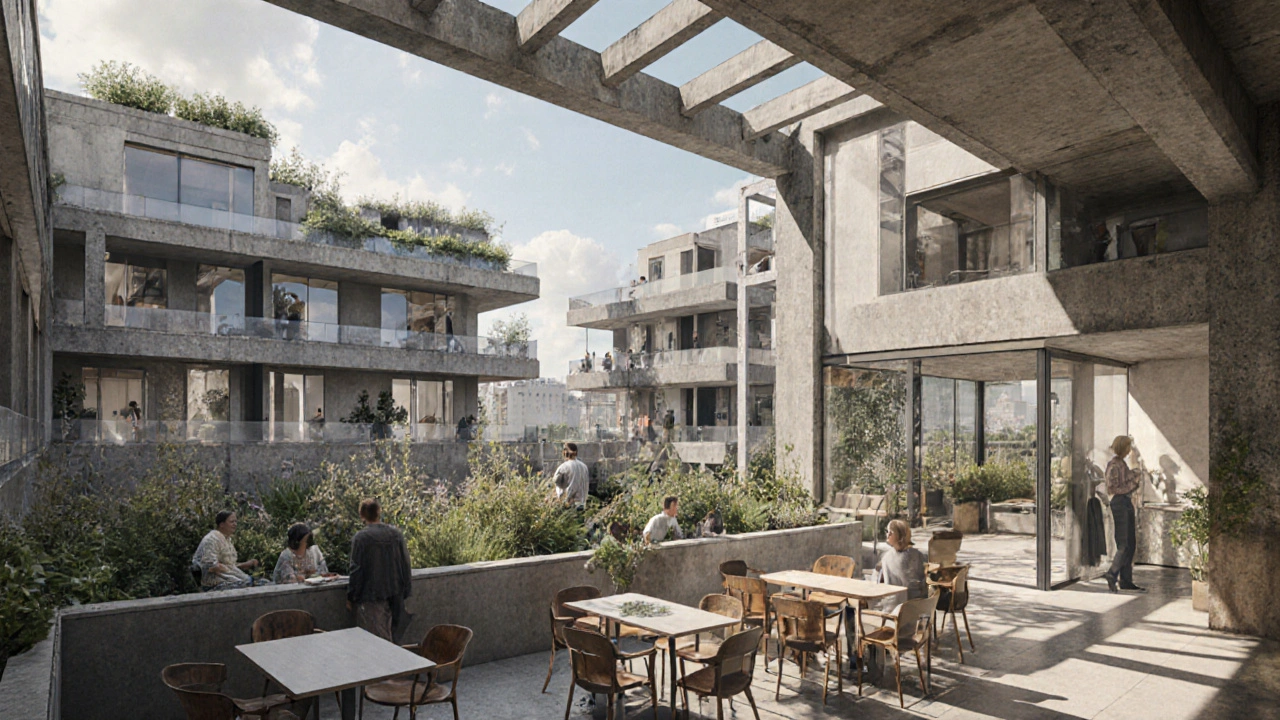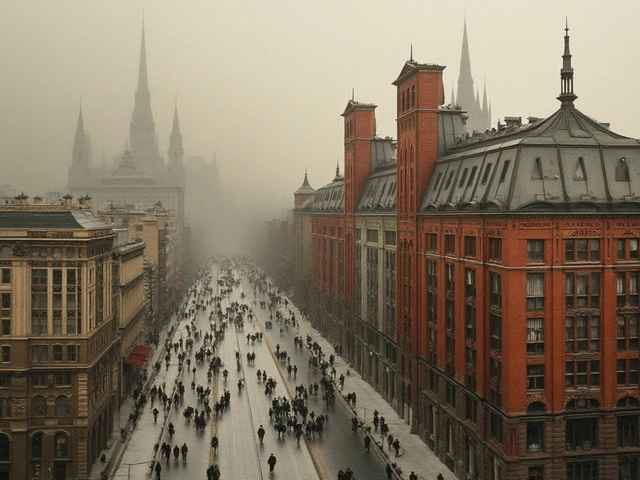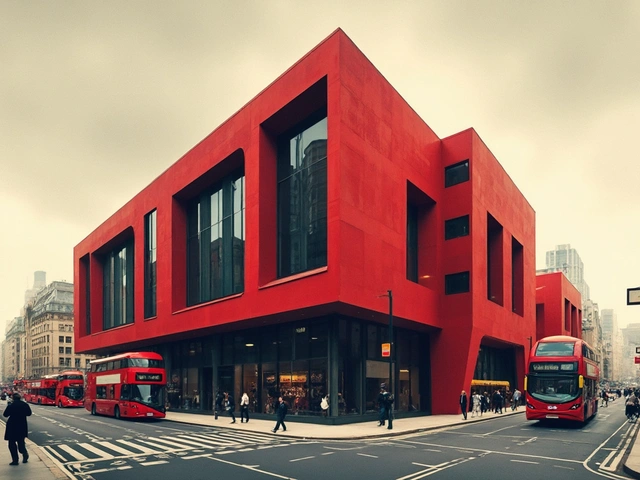When you see a building that looks like it was built from steel beams, glass, and raw concrete-angled, stacked, and bursting with energy-you’re likely looking at constructivist architecture. It doesn’t whisper. It shouts. And it still does, nearly 100 years after it first appeared on the streets of Moscow. This isn’t just old-school design. It’s a revolution in brick and steel that still influences how we think about space, function, and social purpose in buildings today.
What Constructivist Architecture Really Is
Constructivist architecture emerged in Russia right after the 1917 Revolution. It wasn’t about decoration. It wasn’t about tradition. It was about building a new world. Architects like Vladimir Tatlin, El Lissitzky, and the Vesnin brothers saw buildings as tools-for education, for industry, for collective living. They didn’t want to make palaces for the rich. They wanted to make housing, factories, and clubs that could lift up the working class.
At its core, constructivism rejected ornament. No columns. No cornices. No fake marble. Instead, it used raw materials: steel, glass, concrete. Forms were bold, asymmetrical, often dynamic. Think of a building that looks like it’s in motion-leaning forward, twisting upward, or jutting out like a machine part. That’s constructivism.
It was deeply tied to the idea of constructivist architecture as a social project. A workers’ club wasn’t just a place to gather-it was meant to re-educate, to organize, to inspire. A communal housing block wasn’t just shelter-it was designed to break down class barriers by sharing kitchens, laundries, and childcare spaces. The architecture itself was supposed to change behavior.
The Icons: Buildings That Still Stand
Not many constructivist buildings survived Stalin’s crackdown on modernism in the 1930s. But a handful still stand-and they’re breathtaking.
The Tatlin’s Tower, never built, remains the most famous symbol. Designed in 1919, it was meant to be a 400-meter spiral of steel and glass, housing rotating government chambers. Even as a model, it looked like a spaceship from the future. It never rose above the drawing board, but its influence? It’s everywhere.
The Narkomfin Building in Moscow, completed in 1932, is one of the few surviving examples. Designed by Moisei Ginzburg and Ignaty Milinis, it was a social experiment in communal living. Apartments had minimal private space-kitchens and bathrooms were shared. The goal? To free women from domestic labor and let them participate fully in society. Today, it’s crumbling, but its layout still inspires architects working on co-housing projects in Berlin, Tokyo, and Melbourne.
The Workers’ Club of the Zuev Sugar Factory by Ilya Golosov is another gem. Its curved glass facade and cantilevered balconies look like something from a 1960s sci-fi movie. But it was built in 1929. Inside, the space was designed for lectures, debates, and theater-spaces meant to build collective consciousness.
These buildings weren’t just functional. They were poetic. They used geometry not for decoration, but to express movement, energy, and progress. A staircase wasn’t just a way to get upstairs-it was a ramp for social mobility.
Why It Was Killed
By the mid-1930s, Stalin had had enough. Constructivism was too radical, too international, too un-Russian. He replaced it with neoclassical grandeur-massive columns, marble halls, and statues of heroic workers. The new style, called Stalinist architecture, was meant to look eternal, stable, and imperial. Constructivism? It was labeled “formalist,” “bourgeois,” and “anti-people.”
Many buildings were left to rot. Others were gutted. The Narkomfin Building’s shared kitchens were sealed off. Windows were bricked in. Balconies were turned into storage. The social vision was erased, brick by brick.
But the ideas didn’t die. They went underground. Architects in the West, especially in Germany and the Netherlands, kept studying them. The Bauhaus school, though separate, shared the same belief: form follows function. And when modernism exploded after World War II, constructivism was quietly there-in the exposed beams of Le Corbusier’s Unité d’Habitation, in the raw concrete of Brutalism, in the modular housing of post-war Europe.

Why It Matters Today
Look around. The world is facing housing shortages, climate crises, and social isolation. Constructivist architecture didn’t just build buildings. It built solutions.
Modern co-living spaces in London and San Francisco? They’re borrowing directly from Narkomfin. Shared kitchens. Rooftop gardens. Community rooms. The same ideas. The same goal: reduce waste, build connection, reclaim space.
Even tech companies are starting to notice. Google’s campus designs, with open workspaces and communal zones, echo constructivist thinking. Not because they’re socialist-but because they’re smart. People work better when they’re not isolated. When spaces are designed for interaction, not just efficiency.
And in cities like Berlin and Amsterdam, architects are restoring constructivist buildings. Not as museums. But as homes. As clinics. As community centers. They’re stripping away the decades of neglect, reopening shared spaces, and letting the original spirit breathe again.
It’s not nostalgia. It’s relevance.
The Aesthetic That Changed Everything
Constructivist architecture didn’t just use new materials. It used new thinking. It asked: What if a building could be a machine for living? What if a staircase could be a symbol of equality? What if a wall didn’t need to be painted-but could be a canvas for propaganda, for art, for thought?
Its visual language-sharp angles, diagonal lines, exposed structures-became the foundation for later movements. Brutalism. Deconstructivism. Even high-tech architecture in the 1980s borrowed its honesty about materials.
Today, you can see its DNA in the Geometric design of the Heydar Aliyev Center in Baku, the tilted walls of the Walt Disney Concert Hall, and the raw concrete of the Barbican Estate in London. All of them owe something to the Russian revolutionaries who believed buildings could change the world.
It’s not about making everything look like a 1920s Soviet factory. It’s about remembering that architecture doesn’t have to be decorative. It can be direct. Honest. Purposeful.

Where to See It Today
If you want to experience constructivist architecture firsthand, head to Moscow. The Narkomfin Building is still there, though it’s been partially restored. The Ginzburg House, the former studio of Moisei Ginzburg, now houses an architecture museum. The Vkhutemas school building-where the movement was taught-is still standing near the Kremlin.
Outside Russia, the Soviet modernism legacy is harder to find. But in cities like Riga, Kyiv, and Minsk, you’ll still spot factory buildings with bold horizontal lines and rooftop terraces. In Poland, the Warsaw housing estates from the 1950s carry its echoes. Even in Australia, a few post-war public housing blocks in Melbourne and Sydney borrowed its modular, functional approach.
It’s not a style you see every day. But when you do, you recognize it. It doesn’t blend in. It demands attention.
The Legacy: More Than Buildings
Constructivist architecture wasn’t just about form. It was about belief. Belief that design could be a force for justice. That a building could be more than shelter-it could be a teacher, a tool, a weapon against inequality.
Today, we talk about sustainable design. Equitable housing. Community-centered spaces. We think we invented these ideas. But they were already being built in Moscow in 1928.
Constructivism reminds us that architecture doesn’t have to be pretty to be powerful. It doesn’t have to be expensive to be transformative. It just has to be honest. And purposeful.
That’s why it still matters. Not because it’s old. But because it’s still right.
What makes constructivist architecture different from other modernist styles?
Unlike Bauhaus or International Style, which focused on minimalism and mass production, constructivist architecture was deeply political. It used bold, dynamic forms to express revolutionary ideals-not just efficiency. It emphasized structural expression, asymmetry, and social function over pure aesthetics. While Bauhaus wanted to make good design affordable, constructivists wanted to make design a tool for social change.
Why are there so few constructivist buildings left?
Stalin banned constructivism in the 1930s, calling it too radical and Western. Many buildings were abandoned, modified, or demolished. Others had their communal spaces sealed off-shared kitchens turned into storage, balconies bricked in. Only a handful survived intact, like the Narkomfin Building. Restoration efforts are only now beginning to reverse decades of neglect.
Can constructivist principles be applied today?
Absolutely. Modern co-living projects, eco-housing, and community centers are reviving constructivist ideas: shared spaces, modular design, exposed structure, and social purpose. Architects in Berlin and Melbourne are using its emphasis on function over ornament to create affordable, sustainable housing that builds community-not isolation.
Is constructivist architecture the same as Brutalism?
They’re related, but not the same. Brutalism, popular in the 1950s-70s, focused on raw concrete and massive forms, often with a heavy, monolithic feel. Constructivism was lighter, more dynamic, and more experimental-using steel, glass, and asymmetry to suggest movement. Brutalism was about permanence; constructivism was about progress.
Who were the key figures in constructivist architecture?
Vladimir Tatlin designed the iconic Tatlin’s Tower. Moisei Ginzburg and Ignaty Milinis built the Narkomfin Building. The Vesnin brothers designed the Workers’ Club of the Zuev Sugar Factory. El Lissitzky, though better known as a graphic artist, also designed architectural projects that fused space and propaganda. These were the pioneers who turned theory into built reality.





